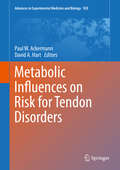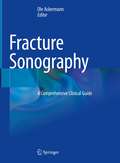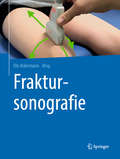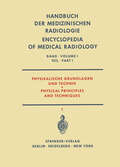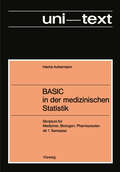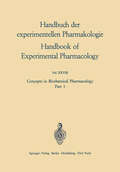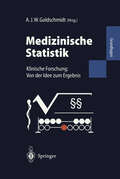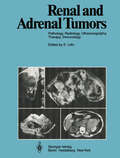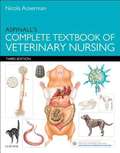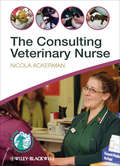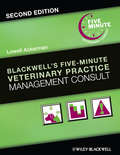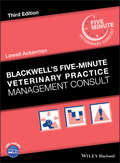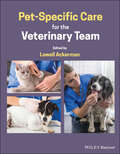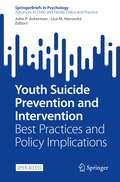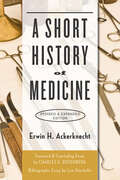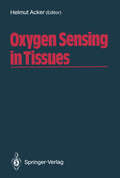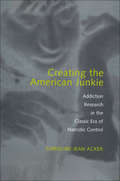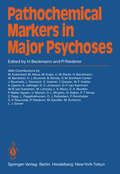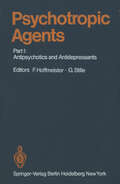- Table View
- List View
Metabolic Influences on Risk for Tendon Disorders (Advances in Experimental Medicine and Biology #920)
by Paul W. Ackermann David A. HartThis book will be of considerable interest to students, practitioners (Doctors, Physiotherapists, and other health care professionals), and researchers who deal with the complex structure of tendons and the need to effectively address tendon disorders. The book is divided into three sections: (1) Basic Biology and Biochemical Markers; (2) Metabolic Disorders; and (3) Novel Therapies. The first section, devoted to the basic biology of tendons, is aimed at those individuals who want to gain basic information on tendons and the subsection on biochemical markers is chiefly aimed at researchers who are developing new studies within this field. The section on metabolic disorders is mainly directed at practitioners who desire to know how metabolic disorders can affect tendons in order to optimize treatment for their patients. Finally, the section on novel therapies is focused on some new treatment options within this field, and discussions regarding how management of tendon disorders needs to incorporate perspectives on current understanding of tendon metabolism.
Fracture Sonography: A Comprehensive Clinical Guide
by Ole AckermannFilling a gap in the literature, this is the first book to comprehensively present fracture sonography as a diagnostic tool that can complement and in some cases even replace conventional radiological imaging. Guiding readers step by step through a patient examination, it is an invaluable guide to implementing this technique in clinical practice. It also presents algorithms, tips, tricks and pitfalls shared by experienced authors, making it a useful reference resource for all those practicing in the field. This book is of interest to a wide readership, including orthopedic, pediatric and trauma surgeons, emergency physicians, pediatric radiologists and general practitioners.
Fraktursonografie
by Ole AckermannDieses Buch bietet einen Überblick über das Spektrum der diagnostischen Fraktursonografie, die die konventionelle radiologische Bildgebung ergänzen und zum Teil auch ersetzen kann. Vorgestellt werden die apparativen und fachlichen Voraussetzungen, die Indikationen und Abläufe und die möglichen Gefahren. Algorithmen, Pitfalls und Tipps zur rechtssicheren Dokumentation runden die Fraktursonografie in der Praxis ab. Damit bietet das Werk alle relevanten Grundlagen zur Umsetzung in die Praxis.
Physikalische Grundlagen und Technik Teil 1 / Physical Principles and Techniques Part 1 (Handbuch der medizinischen Radiologie Encyclopedia of Medical Radiology #1 / 1)
by L. Ackermann A. Bouwers C. Carlsson K. Dümmling U. Goering O. Haxel R. Krebs S. Ledin K. Lidén L. Lorentzon G. A. Magni H. Mergler F. W. Spiers H. Schleussner M. P. Visser F. Wachsmann E. S. Wasser E. Zieler H. VietenBASIC in der medizinischen Statistik: Skriptum für Mediziner, Biologen, Pharmazeuten ab 1. Semester
by Hanns AckermannMehrdimensionale nicht-parametrische Normbereiche: Methodologische und medizinische Aspekte (Medizinische Informatik, Biometrie und Epidemiologie #57)
by Hanns AckermannConcepts in Biochemical Pharmacology: Part 1 (Handbook of Experimental Pharmacology #28 / 1)
by H. S. AckermannThis volume of the Handbook of Experimental Pharmacology (Concepts in Biochemical Pharmacology) will show that pharma cology has finally arrived as a true discipline in its own right, and is no longer the handmaiden of organic chemistry and physiology. Instead it is an amalgam of all the biological sciences including biochemistry, biophysical chemistry, physiology, pathology and clinical medicine. In the volumes that make up Concepts in Bioche mical Pharmacology we hope to convince Medical Schools what should now be obvious, that pharmacology is no longer that dull topic bridging the basic sciences with medicine, but is probably the most important subject in the medical curriculum. We are grateful for the advice of Dr. BYRON CLARKE, Director of the Pharmacology-Toxicology Program at the National Insti tutes of Health, whose support made possible much of the work described in this volume. Contents Section One: Routes of Drug Administration Chapter 1: Biological Membranes and Their Passage by Drugs. C. A. M. HOGBEN 1 References. . . . . . . . . . . . . . . . . . . . . . . . . . 8 Chapter 2: Absorption of Drugs from the Gastrointestinal Tract. L. S. SCHANKER. With 5 Figures. 9 I. Introduction. . . . . . . . . . . . . . . . . . . . . . . 9 II. Methods of Study. . . . . . . . . . . . . . . . . . . . . 9 III. Absorption from the Stomach . . . . . . . . . . . . . . . 11 IV. Intestinal Absorption of Non-Electrolytes and Weak Electrolytes 15 V. Absorption of Weak Electrolytes from the Colon and Rectum 18 VI. Intestinal Absorption of Organic Ions. . . . . . . . . . 19 VII. Intestinal Absorption of Macromolecules . . . . . . . . . . 19 VIII. Active Transport across the Intestinal Epithelium . . . . . 20 IX. Effect of EDTA on Drug Absorption from the Intestine . . . . . . .
Medizinische Statistik: Klinische Forschung: Von der Idee zum Ergebnis
by H. Ackermann M. Herbold C. Kluss B. Schaaf R. Weiß J. WindelerDie zentralen Aufgaben der Biometrie in der medizinischen Forschung sind mit Hilfe dieses Praxisleitfadens mühelos zu verstehen. Anschaulich werden- die Grundbegriffe der deskriptiven Statistik,- Regression und Korrelation,- die Analyse von Überlebenszeiten,- Probleme der Normalität und Referenzbereiche sowie - das "Intention-to-treat"-Prinzipbeschrieben und durch nützliche Hinweise zum Einsatz von Computer- und Statistikprogrammen ergänzt. Für die Studienplanung enthält das Buch Dokumentationsbögen und Musterprüfpläne.Damit macht dieser anwendungsorientierte Ratgeber Klinikern und Wissenschaftlern aller medizinischen Forschungseinrichtungen grundlegende Statistikkenntnisse leicht verfügbar.
Renal and Adrenal Tumors: Pathology, Radiology, Ultrasonography, Therapy, Immunology
by R. Ackerman D. Bachmann A. Baert H. Behrendt D. Beyer W. Bischoff E. Boijsen H.C. Dominick V. Fiedler W.A. Fuchs M. Georgi U. Goerttler M. Goldberg R. Günther W. Havers R. Heckmann H. Holfeld L. Jeanmart J.V. Kaude L.D. Leder E. Löhr M. Marberger G. Marchal P. Mellin A. Moss O. Olsson M. Osteaux H.J. Richter E. Scherer C. Stambolis M.W. Strötges B. Swart Guido WilmsThe present volume constitutes an attempt to compile contem porary features of diagnosis and treatment of renal and adrenal tumors. A thorough survey of the field is ensured by the authors' considerable scientific experience. Tumors of the kidneys and the adrenal glands are being diagnosed and treated by physicians of different medical disciplines. For both types of tumor, the pathologic cellular substrate is of crucial importance in diagnosis and therapy. In recent years significant diagnostic advances have been made, ranging from angiography through ultrasonography and computer tomography to immunology. New impulses in oncologic therapy have occurred in surgery, radiation therapy, and tumor emboliza tion. A further important topic is renal tumors in infants. Such tumors involve special aspects of both diagnosis and therapy and also have a distinctive prognosis. We are indebted both to Springer-Verlag, who supported us in our intention to write this book, and to our colleagues, whose help is greatly appreciated. For the authors: E. LOHR Essen/Heidelberg, September 1979 Contents (Chapters marked with an asterisk have been translated by H.-U. Eickenberg) Pathology of Renal and Adrenal Neoplasms L.-D. Leder, H.J. Richter, and Chr. Stambolis ...... . 1. Tumors and Tumor-Like Lesions of the Kidney in the Adult 1.1. General Remarks . 1.2. Heterotopic Tissue . . . . l.2.l. Adrenal Tissue . . . . . .
Aspinall's Complete Textbook Of Veterinary Nursing (PDF)
by Nicola Ackerman Victoria AspinallThe third edition of Aspinall's Complete Textbook of Veterinary Nursing is the ideal text for both student and qualified veterinary nurses as it covers the entire veterinary nursing syllabus. Now written in the main by veterinary nurses this book comprehensively covers all aspects of the veterinary nursing role from client communication to nutritional support. All chapters have been revised in line with changes in legislation and regulation, but also theoretical and practical aspects. Greater emphasis on the veterinary practice structure including the role of corporate businesses and use of social media bring this edition fully up to date. The new edition welcomes Nicola Ackerman as principal editor. Nicola is past officer of the BVNA and editor of the Veterinary Nursing Journal, and is currently the chair of The Pet Obesity Taskforce. Nicola is a winner of several awards including the Blue Cross/BVNA Veterinary Nurse of the Year 2010. Nicola was the first Veterinary Nurse in the UK to become a veterinary nurse specialist in nutrition. Comprehensive content ideal for both student and qualified veterinary nurses Over 700 full colour illustrations for enhanced understanding Written by veterinary nurses for veterinary nurses Recommended reading given for each chapter to aid further research Evolve Resources containing Self-assessment questions for every chapter to test learning Image Bank of over 700 figures Additional chapters New chapters on Emergency Critical care, Fluid therapy, Practice and Staff management and Consulting skills. Anaesthesia and Analgesia chapter fully revised and updated. New chapter on Equine Behaviour and Handling, including recognition of pain in equines.
The Consulting Veterinary Nurse
by Nicola AckermanThe Consulting Veterinary Nurse is an invaluable source of information for all veterinary nurses setting up and conducting their own nursing clinics in small animal practice. From the basics of setting up the consulting room to running and marketing individual clinics, this book provides a comprehensive coverage of the role of the consulting veterinary nurse. A large section of the book details specific clinics run by nurses, including nutritional assessments, behavioural clinics, puppy parties, seasonal information campaigns, senior pet clinics and medical clinics for a full range of conditions from arthritis and dental problems to epilepsy and cancer. A chapter specifically on rabbit clinics is also included. Written by an experienced senior veterinary nurse, this is a vital guide for all veterinary nurses seeking to develop their consulting role and contribute effectively to the long-term success of their practice. KEY FEATURES Provides a comprehensive guide to the role of the consulting veterinary nurse Details specific nutritional, medical and behavioural clinics run by nurses Includes advice on presentation, marketing and communicating with clients Discusses client compliance and internal procedure and protocol Contains sample diet history sheets and unit conversion charts for use in practice Endorsed by the British Veterinary Nursing Association
The Consulting Veterinary Nurse
by Nicola AckermanThe Consulting Veterinary Nurse is an invaluable source of information for all veterinary nurses setting up and conducting their own nursing clinics in small animal practice. From the basics of setting up the consulting room to running and marketing individual clinics, this book provides a comprehensive coverage of the role of the consulting veterinary nurse. A large section of the book details specific clinics run by nurses, including nutritional assessments, behavioural clinics, puppy parties, seasonal information campaigns, senior pet clinics and medical clinics for a full range of conditions from arthritis and dental problems to epilepsy and cancer. A chapter specifically on rabbit clinics is also included. Written by an experienced senior veterinary nurse, this is a vital guide for all veterinary nurses seeking to develop their consulting role and contribute effectively to the long-term success of their practice. KEY FEATURES Provides a comprehensive guide to the role of the consulting veterinary nurse Details specific nutritional, medical and behavioural clinics run by nurses Includes advice on presentation, marketing and communicating with clients Discusses client compliance and internal procedure and protocol Contains sample diet history sheets and unit conversion charts for use in practice Endorsed by the British Veterinary Nursing Association
Blackwell's Five-Minute Veterinary Practice Management Consult (Blackwell's Five-Minute Veterinary Consult)
by Lowell AckermanBlackwell’s Five-Minute Veterinary Practice Management Consult, Second Edition has been extensively updated and expanded, with 55 new topics covering subjects such as online technologies, hospice care, mobile practices, compassion fatigue, practice profitability, and more. Carefully formatted using the popular Five-Minute Veterinary Consult style, the book offers fast access to authoritative information on all aspects of practice management. This Second Edition is an essential tool for running a practice, increasing revenue, and managing staff in today’s veterinary practice. Addressing topics ranging from client communication and management to legal issues, financial management, and human resources, the book is an invaluable resource for business management advice applicable to veterinary practice. Sample forms and further resources are now available on a companion website. Veterinarians and practice managers alike will find this book a comprehensive yet user-friendly guide for success in today’s challenging business environment.
Blackwell's Five-Minute Veterinary Practice Management Consult (Blackwell's Five-Minute Veterinary Consult)
by Lowell AckermanBlackwell’s Five-Minute Veterinary Practice Management Consult, Second Edition has been extensively updated and expanded, with 55 new topics covering subjects such as online technologies, hospice care, mobile practices, compassion fatigue, practice profitability, and more. Carefully formatted using the popular Five-Minute Veterinary Consult style, the book offers fast access to authoritative information on all aspects of practice management. This Second Edition is an essential tool for running a practice, increasing revenue, and managing staff in today’s veterinary practice. Addressing topics ranging from client communication and management to legal issues, financial management, and human resources, the book is an invaluable resource for business management advice applicable to veterinary practice. Sample forms and further resources are now available on a companion website. Veterinarians and practice managers alike will find this book a comprehensive yet user-friendly guide for success in today’s challenging business environment.
Blackwell's Five-Minute Veterinary Practice Management Consult (Blackwell's Five-Minute Veterinary Consult)
by Lowell AckermanProvides a quick veterinary reference to all things practice management related, with fast access to pertinent details on human resources, financial management, communications, facilities, and more Blackwell's Five-Minute Veterinary Practice Management Consult, Third Edition provides quick access to practical information for managing a veterinary practice. It offers 320 easily referenced topics that present essential details for all things practice management—from managing clients and finances to information technology, legal issues, and planning. This fully updated Third Edition adds 26 new topics, with a further 78 topics significantly updated or expanded. It gives readers a look at the current state of the veterinary field, and teaches how to work in teams, communicate with staff and clients, manage money, market a practice, and more. It also provides professional insight into handling human resources in a veterinary practice, conducting staff performance evaluations, facility design and construction, and managing debt, among other topics. KEY FEATURES: Presents essential information on veterinary practice management in an easy-to-use format Offers a practical support tool for the business aspects of veterinary medicine Includes 26 brand-new topics and 78 significantly updated topics Provides models of veterinary practice, challenges to the profession, trends in companion practices, and more Features contributions from experts in veterinary practice, human resources, law, marketing, and more Supplies sample forms and other resources digitally on a companion website Blackwell's Five-Minute Veterinary Practice Management Consult offers a trusted, user-friendly resource for all aspects of business management, carefully tailored for the veterinary practice. It is a vital resource for any veterinarian or staff member involved in practice management.
Blackwell's Five-Minute Veterinary Practice Management Consult (Blackwell's Five-Minute Veterinary Consult)
by Lowell AckermanProvides a quick veterinary reference to all things practice management related, with fast access to pertinent details on human resources, financial management, communications, facilities, and more Blackwell's Five-Minute Veterinary Practice Management Consult, Third Edition provides quick access to practical information for managing a veterinary practice. It offers 320 easily referenced topics that present essential details for all things practice management—from managing clients and finances to information technology, legal issues, and planning. This fully updated Third Edition adds 26 new topics, with a further 78 topics significantly updated or expanded. It gives readers a look at the current state of the veterinary field, and teaches how to work in teams, communicate with staff and clients, manage money, market a practice, and more. It also provides professional insight into handling human resources in a veterinary practice, conducting staff performance evaluations, facility design and construction, and managing debt, among other topics. KEY FEATURES: Presents essential information on veterinary practice management in an easy-to-use format Offers a practical support tool for the business aspects of veterinary medicine Includes 26 brand-new topics and 78 significantly updated topics Provides models of veterinary practice, challenges to the profession, trends in companion practices, and more Features contributions from experts in veterinary practice, human resources, law, marketing, and more Supplies sample forms and other resources digitally on a companion website Blackwell's Five-Minute Veterinary Practice Management Consult offers a trusted, user-friendly resource for all aspects of business management, carefully tailored for the veterinary practice. It is a vital resource for any veterinarian or staff member involved in practice management.
Pet-Specific Care for the Veterinary Team
by Lowell AckermanA practical guide to identifying risks in veterinary patients and tailoring their care accordingly Pet-specific care refers to a practice philosophy that seeks to proactively provide veterinary care to animals throughout their lives, aiming to keep pets healthy and treat them effectively when disease occurs. Pet-Specific Care for the Veterinary Team offers a practical guide for putting the principles of pet-specific care into action. Using this approach, the veterinary team will identify risks to an individual animal, based on their particular circumstances, and respond to these risks with a program of prevention, early detection, and treatment to improve health outcomes in pets and the satisfaction of their owners. The book combines information on medicine and management, presenting specific guidelines for appropriate medical interventions and material on how to improve the financial health of a veterinary practice in the process. Comprehensive in scope, and with expert contributors from around the world, the book covers pet-specific care prospects, hereditary and non-hereditary considerations, customer service implications, hospital and hospital team roles, and practice management aspects of pet-specific care. It also reviews specific risk factors and explains how to use these factors to determine an action plan for veterinary care. This important book: Offers clinical guidance for accurately assessing risks for each patient Shows how to tailor veterinary care to address a patient’s specific risk factors Emphasizes prevention, early detection, and treatment Improves treatment outcomes and provides solutions to keep pets healthy and well Written for veterinarians, technicians and nurses, managers, and customer service representatives, Pet-Specific Care for the Veterinary Team offers a hands-on guide to taking a veterinary practice to the next level of care.
Pet-Specific Care for the Veterinary Team
by Lowell AckermanA practical guide to identifying risks in veterinary patients and tailoring their care accordingly Pet-specific care refers to a practice philosophy that seeks to proactively provide veterinary care to animals throughout their lives, aiming to keep pets healthy and treat them effectively when disease occurs. Pet-Specific Care for the Veterinary Team offers a practical guide for putting the principles of pet-specific care into action. Using this approach, the veterinary team will identify risks to an individual animal, based on their particular circumstances, and respond to these risks with a program of prevention, early detection, and treatment to improve health outcomes in pets and the satisfaction of their owners. The book combines information on medicine and management, presenting specific guidelines for appropriate medical interventions and material on how to improve the financial health of a veterinary practice in the process. Comprehensive in scope, and with expert contributors from around the world, the book covers pet-specific care prospects, hereditary and non-hereditary considerations, customer service implications, hospital and hospital team roles, and practice management aspects of pet-specific care. It also reviews specific risk factors and explains how to use these factors to determine an action plan for veterinary care. This important book: Offers clinical guidance for accurately assessing risks for each patient Shows how to tailor veterinary care to address a patient’s specific risk factors Emphasizes prevention, early detection, and treatment Improves treatment outcomes and provides solutions to keep pets healthy and well Written for veterinarians, technicians and nurses, managers, and customer service representatives, Pet-Specific Care for the Veterinary Team offers a hands-on guide to taking a veterinary practice to the next level of care.
Youth Suicide Prevention and Intervention: Best Practices and Policy Implications (SpringerBriefs in Psychology)
by John P. Ackerman Lisa M. HorowitzThis open access book focuses on the public health crisis of youth suicide and provides a review of current research and prevention practices. It addresses important topics, including suicide epidemiology, suicide risk detection in school and medical settings, critical cultural considerations, and approaches to lethal means safety. This book offers cutting-edge research on emerging discoveries in the neurobiology of suicide, psychopharmacology, and machine learning. It focuses on upstream suicide prevention research methods and details how cost-effective approaches can mitigate youth suicide risk when implemented at a universal level. Chapters discuss critical areas for future research, including how to evaluate the effectiveness of suicide prevention and intervention efforts, increase access to mental health care, and overcome systemic barriers that undermine generalizability of prevention strategies. Finally, this book highlights what is currently working well in youth suicide prevention and, just as important, which areas require more attention and support. Key topics include: The neurobiology of suicide in at-risk children and adolescents.The role of machine learning in youth suicide prevention.Suicide prevention, intervention, and postvention in schools.Suicide risk screening and assessment in medical settings.Culturally informed risk assessment and suicide prevention efforts with minority youth.School mental health partnerships and telehealth models of care in rural communities.Suicide and self-harm prevention and interventions for LGBTQ+ youth.Risk factors associated with suicidal behavior in Black youth.Preventing suicide in youth with autism spectrum disorder (ASD) and intellectual disability (ID). Youth Suicide Prevention and Intervention is a must-have resource for policy makers and related professionals, graduate students, and researchers in child and school psychology, family studies, public health, social work, law/criminal justice, sociology, and all related disciplines.
A Short History of Medicine
by Erwin H. Ackerknecht Lisa Haushofer.Erwin H. Ackerknecht;€™s A Short History of Medicine is a concise narrative, long appreciated by students in the history of medicine, medical students, historians, and medical professionals as well as all those seeking to understand the history of medicine.Covering the broad sweep of discoveries from parasitic worms to bacilli and x-rays, and highlighting physicians and scientists from Hippocrates and Galen to Pasteur, Koch, and Roentgen, Ackerknecht narrates Western and Eastern civilization;€™s work at identifying and curing disease. He follows these discoveries from the library to the bedside, hospital, and laboratory, illuminating how basic biological sciences interacted with clinical practice over time. But his story is more than one of laudable scientific and therapeutic achievement. Ackerknecht also points toward the social, ecological, economic, and political conditions that shape the incidence of disease. Improvements in health, Ackerknecht argues, depend on more than laboratory knowledge: they also require that we improve the lives of ordinary men and women by altering social conditions such as poverty and hunger.This revised and expanded edition includes a new foreword and concluding biographical essay by Charles E. Rosenberg, Ackerknecht;€™s former student and a distinguished historian of medicine. A new bibliographic essay by Lisa Haushofer explores recent scholarship in the history of medicine.
A Short History of Medicine
by Erwin H. Ackerknecht Lisa Haushofer.Erwin H. Ackerknecht;€™s A Short History of Medicine is a concise narrative, long appreciated by students in the history of medicine, medical students, historians, and medical professionals as well as all those seeking to understand the history of medicine.Covering the broad sweep of discoveries from parasitic worms to bacilli and x-rays, and highlighting physicians and scientists from Hippocrates and Galen to Pasteur, Koch, and Roentgen, Ackerknecht narrates Western and Eastern civilization;€™s work at identifying and curing disease. He follows these discoveries from the library to the bedside, hospital, and laboratory, illuminating how basic biological sciences interacted with clinical practice over time. But his story is more than one of laudable scientific and therapeutic achievement. Ackerknecht also points toward the social, ecological, economic, and political conditions that shape the incidence of disease. Improvements in health, Ackerknecht argues, depend on more than laboratory knowledge: they also require that we improve the lives of ordinary men and women by altering social conditions such as poverty and hunger.This revised and expanded edition includes a new foreword and concluding biographical essay by Charles E. Rosenberg, Ackerknecht;€™s former student and a distinguished historian of medicine. A new bibliographic essay by Lisa Haushofer explores recent scholarship in the history of medicine.
Creating the American Junkie: Addiction Research in the Classic Era of Narcotic Control
by Caroline Jean AckerHeroin was only one drug among many that worried Progressive Era anti-vice reformers, but by the mid-twentieth century, heroin addiction came to symbolize irredeemable deviance. Creating the American Junkie examines how psychiatrists and psychologists produced a construction of opiate addicts as deviants with inherently flawed personalities caught in the grip of a dependency from which few would ever escape. Their portrayal of the tough urban addict helped bolster the federal government's policy of drug prohibition and created a social context that made the life of the American heroin addict, or junkie, more, not less, precarious in the wake of Progressive Era reforms.Weaving together the accounts of addicts and researchers, Acker examines how the construction of addiction in the early twentieth century was strongly influenced by the professional concerns of psychiatrists seeking to increase their medical authority; by the disciplinary ambitions of pharmacologists to build a drug development infrastructure; and by the American Medical Association's campaign to reduce prescriptions of opiates and to absolve physicians in private practice from the necessity of treating difficult addicts as patients. In contrast, early sociological studies of heroin addicts formed a basis for criticizing the criminalization of addiction. By 1940, Acker concludes, a particular configuration of ideas about opiate addiction was firmly in place and remained essentially stable until the enormous demographic changes in drug use of the 1960s and 1970s prompted changes in the understanding of addiction—and in public policy.
Pathochemical Markers in Major Psychoses
by M. AckenheilThis volume contains the proceedings of the symposium Pathochemical Markers in Major Psychoses, held in Vienna in July 1983. The development of biological markers in psychiatric diseases, par ticularly in the field of neurochemistry, has made substantial progress during recent years although the multiple mechanisms of mental illness are still not fully understood. The greatest contribution has come through the development of new therapeutic agents that not only pro vide invaluable help for psychiatric patients but also serve as chemical tools for the investigation of the biological mechanisms underlying the disease. The catecholamine and serotonin hypotheses for major psy choses have been of particular heuristic value and have stimulated im portant research. However, the scope of our scientific endeavours has to be broadened to include other putative biological causes of psychoses, e. g. , pathomorphological changes, aberrations in the metabolism of other amino acids and oflipids, or the formation of endogenous toxins. This book presents new selected studies of the pathochemical bases of schizophrenia and affective psychoses. Although several topics were inevitably not included in this symposium, we nevertheless hope that it represents an integration of basic pathomorphological research with current clinical findings in the area of pathochemical markers in psy chiatry. October 1984 HELMUT BECKMANN PETER RIEDERER Contents Neuromorphological Background of Pathochemical Studies in Major Psychoses K. JELLINGER (With I Figure) . . . . . . . . . . of Psychopathological Classification The Significance in Interpreting Biochemical Findings E. GABRIEL . . . . . . . . . . . . . . . . .
Psychotropic Agents: Part I: Antipsychotics and Antidepressants (Handbook of Experimental Pharmacology #55 / 1)
by M. AckenheilThe volumes on "psychotropic substances" in the Handbook of Experimental Phar macology series clearly show that the classical concept of this discipline has become too narrow in recent years. For instance, what substances are psychotropic is determined not by the criteria of the animal trial, i.e. by experimental pharmacology, but by their action on the psy che, which in the final analysis is only accessible to us in man. Psychotropic substances force experimental pharmacology (and thus also this Handbook) outside its tradition allimits, which have essentially depended on animal studies. The antipsychotics and antidepressants were not discovered in animal ex periments, but by chance (or more precisely, by clinical empiricism). Experienced psy chiatrists trained in the observation of patients recognised the efficacy of drugs, the beneficial effect of which nobody had dreamed of before: DELAY and DENICKER in the case of chlorpormazine, KLINE in the case of the monoamine oxidase inhibitors and KUHN in the case of imipramine. It was only after these discoveries that the pharma cologists developed experimental models of the psychoses in animal experiments. However, even today we still do not know with certainty which of the effects shown in animals is relevant for the clinical effect despite the vast abundance of individual investigations. For many years, this uncertainty led to the testing of antipsychotics (e.g. of the neuroleptic type) in models which actually produced the undesired effects.
